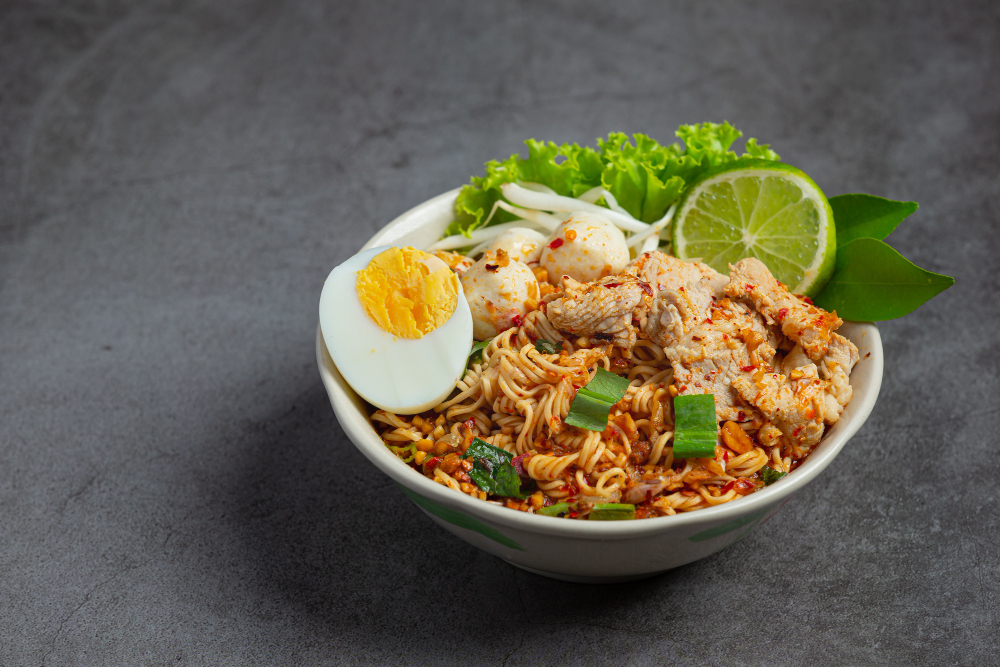Vegetarian Mazemen with Beans and Egg Recipe
Mazemen is a Japanese word which roughly translates to “mixed noodles”. Mazemen, which means “mixed noodles” in Japanese, is essentially ramen without the soup: sleek alkali noodles are blended with a (very) flavourful sauce, fragrant oil, and whatever you might have available at your disposal. They’re a wonderful yet simple way to use up leftovers—roasted meats, poached chicken breast, stir-fried veggies, you name it—and frequently they rely on pantry essentials, like soy sauce and rice vinegar, so the toughest item to find is generally the noodles themselves.
In other Mazemen recipes available such as the XO Mazemen and the bacon and egg Mazemen recipe strong savoury ingredients like XO sauce and bacon were used to give the Mazemen a meaty taste. But for this vegetarian Mazemen recipe, that taste is provided by the liquid used to cook the dried beans; a tiny amount of cooked, mashed beans adds additional body and creaminess. Also, fermented bean paste such as Tauco, Kinema, Tianmianjiang, or Tauchu serves as an alternative to the soy sauce used in XO Mazemen and the bacon and egg Mazemen recipe.
The end product is a savoury, double-bean-y noodle dish that is not only a great way to use up leftovers but also rather tasty on its own. If the egg is left out, the meal is vegan; all you need to do is add a little bit of extra fragrant oil (approximately a tablespoon) for richness and to adequately moisten the noodles (and lessen their saltiness).
I have tested and tried this dish with different types of dried beans—fava, scarlet runners, white beans, mung, and chickpeas. They all gave great flavours. The only disparity I noticed was that the fava, mung, chickpeas and white beans made an attractive meal you would love to eat while the scarlet runner looked like an inky mess in appearance. The major thing to keep in mind is that the dried bean cooking liquid is essential in giving this meal flavour. Also, ensure you cook your dried beans with the right amount of salt and spices to get a tasty meal.
If you are using canned beans NEVER use the liquid that is with the can. You might be curious to know why. Well, to start with, the liquid from the can isn’t particularly tasty. It is also very viscous, and when combined with the other sauce ingredients causes the sauce to become unattractively thick and heavy. If using canned beans, it is preferable to substitute the boiling liquid with low-sodium store-bought chicken stock or vegetable stock.
For the noodles, you may use store-bought alkaline noodles, whether from a specialist noodle producer like Sun Noodle or the dried ones found in an instant ramen packet.
I STRONGLY RECOMMEND dressing each part separately, like you would with other Mazemen recipes. This is because I believe that cooking more than one portion at a time is not ideal, especially when using thinner noodles, which are much more difficult to divide equally after being properly combined with the sauce. A single part of noodles makes it simpler to quickly create a beautiful emulsion than two or four sections do.

Ingredients
- 240ml of bean cooking liquid or homemade or store-bought low-sodium chicken stock or vegetable stock (if you’re using canned beans)
- 65g cooked dry beans or canned beans (drained properly)
- Quarter cup of fermented bean paste
- 60ml sesame oil or other fragrant oil
- 20ml rice vinegar
- Kosher salt
- 4 portions of ramen noodles, either purchased or prepared at home
Directions
- A big pot of water should be brought to a boil.
- While this is going on put the beans and bean cooking liquid in a microwave-safe container, and heat on high for 1 to 2 minutes, or until the beans are steaming (timing will depend on strength of your microwave). In a small saucepan, combine the beans and bean cooking liquid. Place the pan over medium-high heat, and cook the mixture for 3 to 4 minutes, or until the beans and liquid are both boiling.
- Transfer the hot bean mixture to a blender jar, an immersion blender cup, or a similar tall-sided dish that fits your immersion blender’s head just right. Blend in the oil, vinegar, and fermented bean paste for approximately a minute, or until fully smooth. Add salt to taste, pour 1/2 cup (120 ml) of the sauce into a large mixing bowl, and save the remaining sauce.
- Once the water is boiling, add one piece of the noodles and cook as directed on the box or in the recipe.
- Add cooked noodles to a dish with sauce after gently draining in a colander or noodle basket. Toss and mix the noodles briskly in the liquid at the bottom of the dish for approximately 30 seconds, or until they are thoroughly covered with sauce, using tongs or chopsticks. After tasting, add extra vinegar and salt as desired to the dish’s flavour.
- Place the dressed noodles in a serving bowl, then spoon any extra sauce on top using a rubber spatula. Add sliced scallions and an onsen egg as a garnish (if using). (Additional cooked beans, poached, roasted, or pan-seared meats, or leftover sautéed or roasted veggies) can be added as desired or as they become available. Serve right away.
- After each round, clean the mixing bowl and repeat steps 4 through 6 with the remaining pieces of noodles and sauce, dressing each serving of noodles with 1/2 cup (120ml) of sauce.

